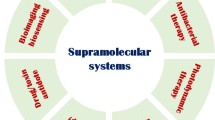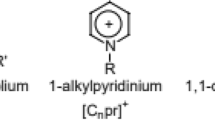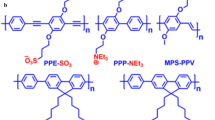Abstract
A novel randomly branched polycation with good proton-buffering capability over a wide pH range (named PTEG) and its polyplexes with DNA were prepared and characterized by various techniques. Characterization via 1H NMR, 13C NMR, FTIR, TGA, DSC, element analysis and protonation titration showed the structure and physical, chemical properties of PTEG. Characterization via electrophoresis, dynamic light scattering, zeta potential analysis and AFM showed that PTEG and DNA formed colloidal complexes. The reason of strong proton-buffering capability below pH 7.4 (that is, proton sponge effect) of PTEG was deeply studied and the results showed that it had no relation with amino group kind. The real reason was series-wound coupled amino groups connected by two carbons, which provides a basis for the synthesis of cationic polymers with strong proton sponge effect.
















Similar content being viewed by others
References
Ahn CH, Su YC, You HB, Kim SW (2002) Biodegradable poly(ethylenimine) for plasmid DNA delivery. J Control Release 80:273–282
Chun MK, Cho CS, Choi HK (2002) Mucoadhesive drug carrier based on interpolymer complex of poly(vinyl pyrrolidone) and poly(acrylic acid) prepared by template polymerization. J Control Release 81:327–334
Demchenko VL, Shtompel VI, Riabov SV, Goncharenko LA, Kobylinskyi SM, Iurzhenko MV (2020) Preparation and characterization of Cu/Cu2O-containing nanocomposites based on interpolyelectrolyte complexes of pectin-polyethyleneimine. Appl Nanosci 10(12):5479–5488
Kolibaba TJ, Grunlan JC (2019) Environmentally benign polyelectrolyte complex that renders wood flame retardant and mechanically strengthened. Macromol Mater Eng 304:1900179
Kovacevic D, Borkovic S, Pozar J (2007) The influence of ionic strength, electrolyte type and preparation procedure on formation of weak polyelectrolyte complexes. Colloid Surface A 302:107–112
Leong JY, Yang C, Tan J, Tan BQ, Hor S, Hedrick JL, Yang YY (2020) Combination of guanidinium and quaternary ammonium polymers with distinctive antimicrobial mechanisms achieving a synergistic antimicrobial effect. Biomater Sci 8:6920–6929
Levy L, Izbitski A, Mishael YG (2019) Enhanced gemfibrozil removal from treated wastewater by designed “loopy” clay-polycation sorbents: Effect of diclofenac and effluent organic matter. Appl Clay Sci 182:105278
Lim YB, Kim SM, Suh H, Park JS (2002) Biodegradable, endosome disruptive, and cationic network-type polymer as a highly efficient and nontoxic gene delivery carrier. Bioconjugate Chem 13:952–957
Orazzhanova LK, Kassymova ZS, Mussabayeva BK, Klivenko AN (2020) Soil structuring in the presence of the chitosan-polyacrylic acid interpolymer complex. Eurasian Soil Sci 53:1773–1781
Ruiz-Rubio L, Alvarez V, Lizundia E, Vilas JL, Rodriguez M, Leon LM (2015) Influence of alpha-methyl substitutions on interpolymer complexes formation between poly(meth)acrylic acids and poly(N-isopropyl(meth)acrylamide)s. Colloid Polym Sci 293:1447–1455
Sakar-Deliormanli A (2012) Flow behavior of hydroxypropyl methyl cellulose/polyacrylic acid interpolymer complexes in aqueous media. Polym Int 61:1751–1757
Seo J, Moon J, Moon S, Paik U (2015) Interpolymer complexes of poly(acrylic acid) and poly(ethylene glycol) for low dishing in STI CMP. Appl Surf Sci 353:499–503
Slyusarenko NV, Vasilyeva NY, Kazachenko AS, Gerasimova MA, Slyusareva EA (2020) Synthesis and properties of interpolymer complexes based on chitosan and sulfated arabinogalactan. Polym Sci Ser B 62:272–278
Takahashi T, Hirose J, Kojima C, Harada A, Kono K (2007) Synthesis of poly(amidoamine) dendron-bearing lipids with poly(ethylene glycol) grafts and their use for stabilization of nonviral gene vectors. Bioconjugate Chem 18:1163–1169
van Lente JJ, Claessens MMAE, Lindhoud S (2019) Charge-based separation of proteins using polyelectrolyte complexes as models for membraneless organelles. Biomacromol 20:3696–3703
Xie PW, Liu P (2019) Core-shell-corona chitosan-based micelles for tumor intracellular pH-triggered drug delivery: improving performance by grafting polycation. Int J Biol Macromol 141:161–170
Zhang Y, Jin Q, Chen Y, Zhao J (2011) Stable and pH-responsive core-shell nanoparticles based on HEC and PMAA networks via template copolymerization. J Nanopart Res 13:4451–4461
Zhong WQ, Chang YY, Lin YL, Zhang AQ (2020) Synthesis and antifungal activities of hydrophilic cationic polymers against Rhizoctonia solani. Fungal Biol 124:735–741
Acknowledgements
This work was supported by Scientific and Technological Project of Jiangxi Province Education Department (GJJ161063). Professor Xiao-hong Li is thanked very much for the authorized use of many measuring equipments. Chuan-bao Wu sincerely acknowledges Dr. Ye Yang for a lot of measurement help.
Author information
Authors and Affiliations
Corresponding author
Ethics declarations
Conflict of interest
The authors declare no competing interests.
Additional information
Publisher's Note
Springer Nature remains neutral with regard to jurisdictional claims in published maps and institutional affiliations.
Rights and permissions
About this article
Cite this article
Wu, CB., Hao, JY., Liu, KQ. et al. PTEG, a novel polycation with strong proton-buffering capability in wide pH range: synthesis, proton-buffering capability source and colloidal complexes of DNA. Appl Nanosci 12, 2331–2343 (2022). https://doi.org/10.1007/s13204-022-02508-4
Received:
Accepted:
Published:
Issue Date:
DOI: https://doi.org/10.1007/s13204-022-02508-4




